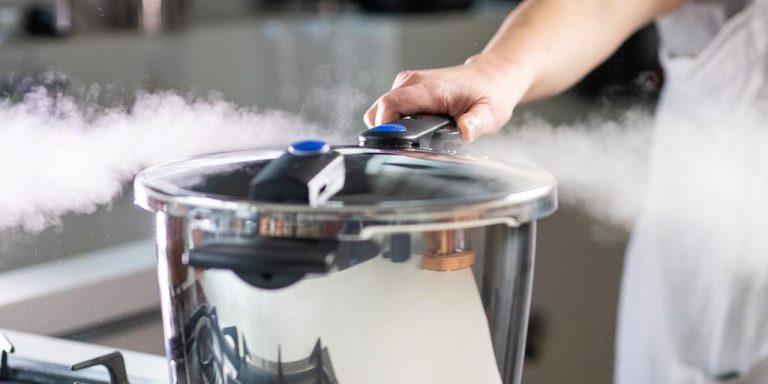
The cooker has been resting on a mild flame for a while and suddenly, like a person just about to sneeze, the pressure pushes the weight and the cooker whistles.
The Bat-Signal for cooked food!
But how does this work? Why does pressure help?
We all know that water boils at 100 degrees. In a regular pot, it isn’t possible to increase the temperature of water more than that. At 100 degrees, the heat energy from the flame starts breaking the molecules of water and converts it from the “liquid” phase to the “steam/gas” phase. The temperature of the water remains constant at 100 degrees until the very last drop of water has boiled off or converted to steam.
Thus water limits the cooking temperature and prevents the food from getting charred or burnt.
However, if you could find a way to increase the temperature of the water beyond 100 degrees, you could cook the food faster.
Enter Pressure!
When water hits boiling point, the steam has nowhere to go in a pressure cooker. the steam fills up, increases the pressure. The rise in pressure will cause the boiling point of water to increase. This is because the water molecules are pushed together more and can’t “escape” their mutual attraction from their liquid state to become a gas easily. Thus, the boiling point of water goes to 121 degrees and thus more heat is transferred to the food and it cooks faster.
When an optimum pressure is attained in a cooker, the steam pushes the weight on top to escape with an unmissable hiss.
The issue with pressure cookers is the measure of water. IF there is too much water, the food turns into mush and if there is less water, then the water turns to steam and the food comes in touch with the hot metal and gets charred.
Cooking Rice with Electric
There are no whistles in an Electric rice cooker. How do they know when to stop cooking?
When a rice cooker is being used, the water and the rice are kept in a metal bowl in a 2:1 proportion. The cooker has a heating element and there is a spring to press it against the bottom of the cooking bowl to make sure it can conduct the heat well.
Some magnetic materials lose their magnetism at a high temperature which is referred to as the Curie temperature. Electric rice cookers contain a magnet made of an alloy with a curie temperature just above the boiling point of water which is in contact with a spring. As the rice is getting cooked, it absorbs the water. Once all the water has been absorbed, the temperature will go above the boiling point of water. This causes the alloy to lose its magnetism and it breaks contact with the spring to disconnect the heating element from the vessel.
